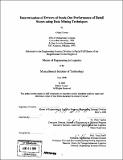Determination of drivers of stock-out performance of retail stores using data mining techniques
Author(s)
Usman, Khalid, M. Eng. Massachusetts Institute of Technology.
DownloadFull printable version (10.47Mb)
Other Contributors
Massachusetts Institute of Technology. Engineering Systems Division.
Advisor
Chris Caplice.
Terms of use
Metadata
Show full item recordAbstract
This research applies data mining techniques to give a picture of the interaction of performance variables such as between stock-outs and store attributes, and stock-outs and other variables including store sales, income and demographic data, as well as various aspects of inventory management data. This research uses three data mining techniques: multiple ordinary-least-squares (OLS) regression, logistic regression and data clustering. The first part of the research evaluates how the effect of stock-outs at the distribution center (DC) level impacts the downstream sales at the store-level. Using multiple regression techniques, it was observed that stock-outs at the distribution center level have a detrimental impact on the sales at the retail store level. The second part of the project focuses on understanding the relationships of store stock-out performance to various drivers. The variables that were determined to be drivers of store performance include income level of the area, demographic profile, years the store has been in operation, day of the week delivery from distribution center, distance of store from the distribution center and average inventory-on-hand. Using data clustering techniques, worse performing and good performing clusters of stores were identified. The two worse performing clusters were 'Low-Income, Newer' stores and 'Newer, Further from DC' stores. The three good performing clusters were 'High-Income, High-Inventory' stores, 'Closer to DC, Older' Stores and 'High-Income, Smaller' stores.
Description
Includes bibliographical references (leaves 66-67). Thesis (M. Eng. in Logistics)--Massachusetts Institute of Technology, Engineering Systems Division, 2008.
Date issued
2008Department
Massachusetts Institute of Technology. Engineering Systems DivisionPublisher
Massachusetts Institute of Technology
Keywords
Engineering Systems Division.